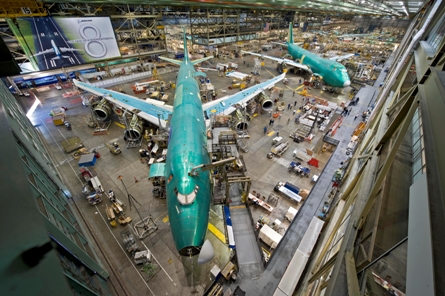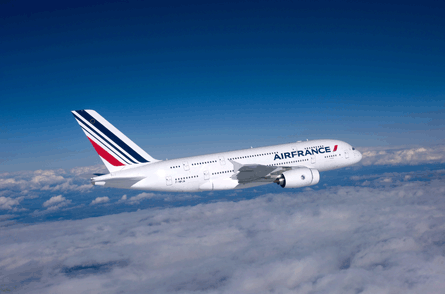When Boeing's 747-100 entered service in 1970, operators around the globe realised unprecedented efficiencies in seat-km costs, reducing the cost of world travel and bolstering the financial bottom line for airlines and later for air freight operators.
However, there is a flipside to the high-capacity coin: airlines flying the jumbo jets carried the burden of a hefty operating costs if they were not able to adequately fill up the aircraft with passengers. Nearly 40 years later, and in the middle of a global recession that now appears to be bottoming, the same dynamic afflicts the big quads, whether in passenger or cargo configuration.
Emirates took delivery of its first of 58 Airbus A380s on order in July 2008, and deployed the 489-seat superjumbo between Dubai and New York Kennedy to much fanfare, only to remove the aircraft from the route in May of this year.
 |
|---|
© Boeing |
The Dubai-based airline redeployed the two aircraft that had served New York daily to Toronto and Bangkok, matching the aircraft with a more appropriate level of demand. But Emirates does plan to return the A380 to New York by June next year, by which time itsfleet will have grown sufficiently.
Large aircraft have been able to offer consolidation of flights and significantly reduced operating costs for a given payload, but near-empty jumbo and superjumbo flights impose high costs. The collapse of both the global cargo market and premium-class travel has shifted the cost burden back to operators, and this has reverberated back to the production planning for Airbus and Boeing.
In September, the International Air Transport Association revised its industry financial forecast downward, predicting that passenger and cargo yields would drop 12% and 15% respectively during 2009. In June IATA had forecast falls of 7% in passenger yields and 11% in cargo yields. Ultimately, the airlines are projected to lose $11 billion in 2009, $2 billion more than originally forecast.
 |
|---|
In April, the softening demand for cargo aircraft slowed Boeing's 747-8 Freighter production ramp-up, sliding the first delivery of the 747-8I passenger variant by three to six additional months to the fourth quarter of 2011. Lufthansa remains the only airline customer for the type, with an order for 20 aircraft. Boeing holds orders for seven VIP-configured 747-8I aircraft as well.
RECESSION STUNTS SALES
The recession has virtually stunted sales in this market segment. Airbus has notched just two orders for the A380 in 2009, while therehave been no new orders and one cancellation for Boeing's 747-8. In addition, current order holders have deferred delivery due to sharp declines in demand.
In the short term, the external forces weighing on the large passenger and cargo aircraft market for Airbus and Boeing are supplemented by internal factors at each company, which have significantly challenged production of both the A380 and 747-8.
The first of two 747-8I service-entry slips announced this year came in April, and followed a series of production issues within Boeing's supply chain and design changes first revealed in November 2008.These pushed the introduction of the first of 78 747-8Fs on order back to the third quarter of 2010.
The second rescheduling came in October 2009, when the diversion of engineering resources to the 787 programme led to the 747-8F's first flight slipping to early 2010, and service entry to the fourth quarter of next year.
 |
|---|
© Airbus |
Boeing also absorbed a hefty $1 billion charge, forcing the programme into a loss position. Increased production costs due to engineering changes contributed to $640 million of the $1 billion, while the balance of $360 million was attributed to the slowing ofproduction caused by the collapse in the cargo market.
The production challenges were not brought about by one single item, but rather the accumulation of small issues that added up to the latest delay to the programme.
A380 production - according to one customer - is still suffering "niggling delays", and Airbus aims to deliver 13 this year - one more than in 2008. The airframer handed over just six A380s during the first nine months of 2009, so must ship seven in the last three months to achieve its target - including the first two aircraft to Air France.
By the close of 2009 Airbus should have delivered 26 of 200 A380s on order to four operators - Air France, Emirates, Qantas and Singapore Airlines.
The 2009 delivery target has been progressively revised downward to 13 from a once planned 25 deliveries, a figure that was reduced to 21 in May 2008. By January 2009, that number had dropped to 18, and it fell again to 14 in May, due to airline deferrals.
Airbus now forecasts it will hand over 20 superjumbos in 2010, half of the 40 it planned to build according to the original production plan.
This year saw the transition between production of Wave 1 and Wave 2 A380s.Full production-standard wiring has replaced a hand-wiring process. Despite this shift, cabin configurations selected by new customers have caused a slowing of production, due to the engineering complexity of integrating the highly complex cabins.
 |
|---|
Even with the current pain in the marketplace discouraging major expansions in cargo and passenger capacity, Airbus and Boeing continue to disagree on the long-term size of the very large aircraft market.
Boeing has revised downward its 20-year forecast from 980 in 2008 to just 740 units between 2009 and 2028, 490 of those being freighters.
Airbus forecasts a similar number of large cargo freighters, around 514, but envisions a market for 1,318 very large passenger aircraft over the next 20 years, up from 1,283 estimated 20 months earlier.
With the delivery of the 10th A380 to launch customer Singapore Airlines, September marked a changing of the guard of sorts at the airline. Its A380 fleet now outnumbers its 747-400s, gradually being phased out of the fleet by the end of the 2010/11 fiscal year.
Singapore Airlines first introduced the 747 in 1972 and has taken delivery of 75 passenger versions of the original jumbo, plus an additional 18 freighters, making it formerly one of the largest 747 operators in the world.
Next year will see an ever growing number of A380s entering service. For its part, Boeing plans to begin the certification campaign for the next-generation 747-8 freighter early in 2010, while completing engineering releases and commencing production of the 747-8I.
Source: Flight International
















